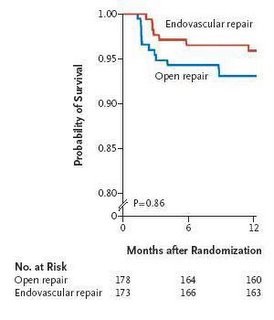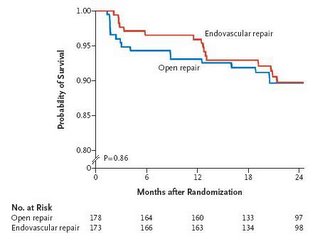At 1 year of follow-up, we observe an impressive advantage of endocascular repair:

This difference vanished, however, at 2 years of follow-up:

Just another demonstration of the perils of early RCT termination for benefit. The conclusion would have been very different had the DREAM researchers terminated the trial for observed benefit at 1-year of follow-up.
Note that I'm making an almost surely wrong assumption here, that every subject was enrolled at the same time and followed simultaenously, such that at 1-year interim analysis an exaggerated benefit was observed. In fact patients are enrolle on a rolling basis and each is followed until the patient is lost-to-follow-up or until the planned follow-up time is reached. This subtle difference in timing introduces statistical problems for Cox proportional hazards model..
Dr. Hans van Houwelingen at Leiden Univ Medical Center showed in a recent article in Statistics in Medicine, due to the model assumptions of Cox proportional hazards model, when it is used in interim analysis, it may be estimating the final treatment effect with bias.
Review pending.
Technorati Tags:
medicine statistics clinical trials interim analysis



No comments:
Post a Comment